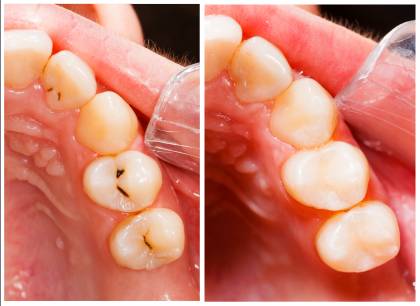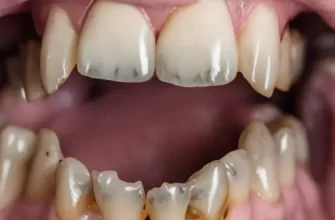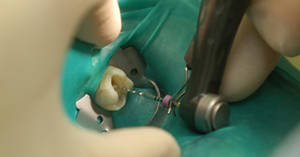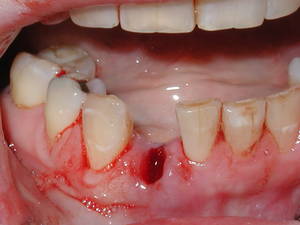Dental filling is a technique in dentistry that is employed to fix cavities and renew compromised teeth. This procedure involves the elimination of the decayed segment of the tooth and the application of a filling substance to fill the void. This safeguard ensures that the tooth does not deteriorate further and regains its original functionality.
The Tooth Filling Procedure
Proper oral care is crucial for good dental health, but occasionally tooth decay can lead to cavities that need to be addressed to prevent more harm. When this happens, a dentist can perform a procedure called tooth filling. This guide will provide a detailed explanation of the process, giving you a thorough understanding of what to anticipate.
Step 1: Initial Examination
In order to determine if you need a tooth filling, the dentist will carefully examine your teeth. They will check for visible signs of decay and may also take dental X-rays to assess any hidden damage. If a cavity is found, the dentist will suggest getting a tooth filling.
Step 2: Numbing the Area
Prior to starting the filling treatment, the dentist will provide you with a local anesthetic to guarantee your ease and comfort throughout the procedure. The anesthesia will be applied to the gum tissue surrounding the troubled tooth through an injection, thereby numbing the area and reducing any possible discomfort.
Step 3: Removing Decay
After numbing the affected area, the dentist will use a dental drill or laser to eliminate the decayed part of the tooth. This procedure might also involve extracting any harmed enamel or dentin, resulting in a clean and healthy space that can be filled.
Step 4: Cleaning and Preparing the Tooth
Once the damaged parts are taken out, the dentist will meticulously cleanse the region to ensure complete removal of bacteria and debris. Subsequently, they will prepare the surface of the tooth by treating it with an acidic gel or conditioner, which roughens it up, enhancing the bonding ability of the tooth filling material.
Step 5: Placing the Filling Material
Once the tooth is prepared, the dentist will choose the suitable filling substance taking into account factors like the cavity’s location, size, and your dental background. Typical filling materials consist of silver amalgam, tooth-colored composite resin, or gold. The dentist will then skillfully and attentively insert the chosen filling substance into the prepared cavity, shaping it to achieve a result that looks natural.
Step 6: Shaping and Polishing
After placing the filling material, the dentist will mold and polish it until it matches the texture of your natural tooth. This is done to enhance your ability to bite and chew correctly. Moreover, the dentist will examine your bite to confirm that it is not impacted by the new filling. Any required modifications will be made if needed.
Step 7: Final Inspection
After shaping and polishing the filling, the dentist will conduct a final inspection to ensure it meets their high-quality standards. They will examine the filling’s appearance, stability, and functionality. This thorough evaluation ensures the longevity and success of the tooth filling.
Step 8: Post-Treatment Instructions
Before the procedure ends, the dentist will provide you with post-treatment instructions to promote healing and reduce any potential discomfort. They might advise you to avoid eating or drinking for a specific period, restrict certain foods, practice good oral hygiene, and schedule a follow-up appointment to monitor the filling’s status.
Tooth Filling Types and Cost of Each One
To maintain good oral health, tooth fillings are crucial for treating cavities or tooth decay. However, it’s important to note that there are several types of available fillings, each with its own pros, cons, and price. Let’s examine the different options and their respective costs.
- Amalgam Fillings:
- Silver fillings, which are also referred to as amalgam fillings, are a popular and affordable choice.
- These items have a strong build and are able to withstand the pressure exerted during the act of biting.
- Because of their unique silver color, they stand out more in comparison to other choices.
- On average, it costs approximately $50 to $150 for each tooth to receive an amalgam filling.
- Composite Fillings:
- Composite fillings, which are also referred to as tooth-colored or white fillings, seamlessly match the original shade of your teeth.
- Amalgam fillings do not provide the same level of aesthetic appeal as the alternative option.
- Composite fillings can be applied to both front and back teeth, showing their flexibility and adaptability.
- On average, a composite filling for one tooth typically costs between $90 and $250.
- Ceramic Fillings:
- Ceramic fillings, which are also referred to as porcelain fillings, offer a greatly pleasing outcome in terms of appearance.
- These dental materials are resistant to staining and can be color-matched to blend with your own teeth.
- Ceramic fillings are created specifically for each individual in a lab and necessitate several appointments.
- Because of their state-of-the-art manufacturing technique, they have a tendency to be pricier.
- The price for a ceramic filling can vary between $250 and $4,500 per tooth, depending on how complicated and large the restoration is.
- Gold Fillings:
- Gold fillings have a high level of durability and longevity.
- Multiple visits are necessary for their production and they are individually created in a specialized facility.
- The unique color of gold fillings makes them easily noticeable.
- The price of a gold filling can differ significantly, varying from $250 to $4,500 per tooth, depending on the size and complexity of the dental restoration.
What happens if you don’t get your teeth filled on time?
Neglecting to get your teeth filled on time can lead to serious consequences. The decay in your teeth can worsen, causing pain and discomfort. It may result in infection and the need for more extensive dental treatments like root canals or tooth extractions. Prompt dental care is crucial for maintaining oral health.










